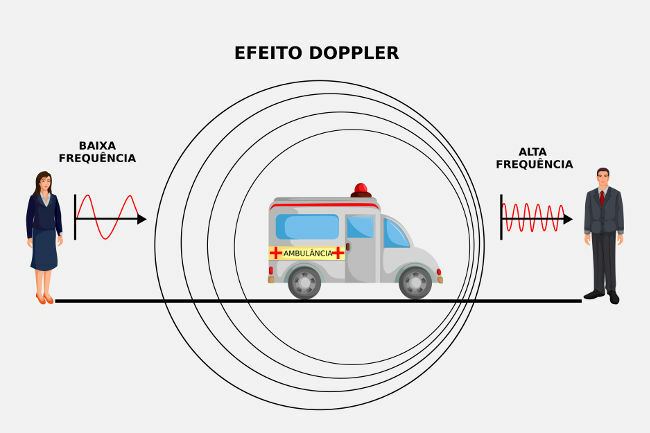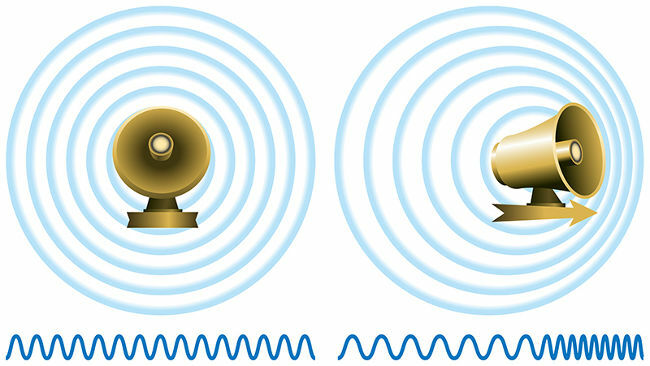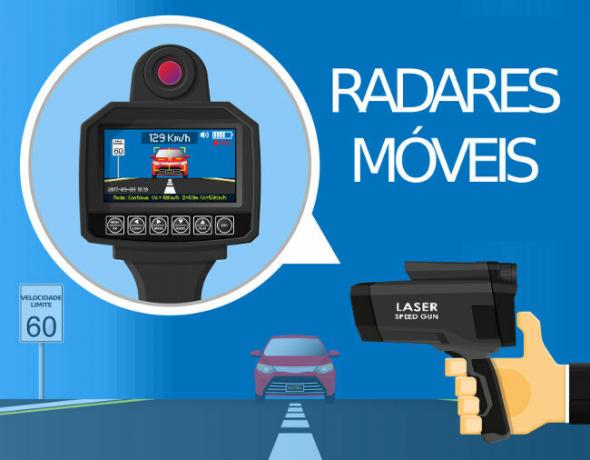Doppler effect is a phenomenon undulatory characterized by the change of lengthinwave or from frequency of a wave emitted by a source that moves relative to an observer.
What is the Doppler Effect?
It is madeDoppler is a physical wave phenomenon that occurs when there is approximation or removalrelative between a wave source and an observer. This phenomenon happens because the velocityinpropagationinonewave, whatever it may be, depends exclusively on the means by which this wave propagates. Thus, even if the source of the waves or the observer moves, the propagation speed of the wave will not change. However, there will be a variation in the wavelength and frequency of the wave captured by the observer.
THE velocityinpropagation of any wave, be it a mechanical wave (sound) or an electromagnetic wave (light), it keeps a proportional relationship with its wavelength and with its oscillation frequency. Watch:

v – wave propagation velocity (m/s)
λ – wavelength (m)
f – oscillation frequency (Hz or s-1)
Imagine the following situation: an ambulance with its siren on travels down a street moving away of an observer and approaching from another observer. Look at the image below:

How the propagation speed of sound waves It dependsonlyofquite (in this case, the air), the velocityrelative between the sound waves and both observers will be the same, both in relation to the observer who push away how much in relation to the observer who approach of the source of the waves. In this way, for the speed to remain constant for both observers, occur changes at the lengthinwave (space required for the wave to complete an oscillation) and in its frequency. how these magnitudes are inverselyproportional, it can be said that:
The observer who sees the ambulance moving away will hear a sound with biggerlengthinwave and smallerfrequency, therefore, more serious;
The observer who sees the ambulance approaching will hear a sound of biggerfrequency and smallerlengthinwave, therefore, more acute.
See too: Sound waves

The image above shows a source of sound waves moving and the deformation suffered by the emitted sound wavefronts.
Who Discovered the Doppler Effect?
The Doppler effect was fully described by the Austrian physicist JohannChristianDoppler, in 1842. Experimental proof of this effect was made three years later by Buys Ballot. For this, Ballot carried out a curious experiment in which a band emitted several musical notes on top of a moving locomotive. Meanwhile, a set of observers recorded the notes heard according to the many differentspeeds approach and departure from the train.
Doppler Effect Formula
The general formula used to calculate the frequency change in the Doppler effect is shown below:

f' – observed frequency (Hz)
f0 – emitted frequency (Hz)
v – wave velocity in the middle (m/s)
v0 – observer speed (m/s)
vF– speed of the emitting wave source (m/s)
In order to use the formula shown above, it is necessary to know if there is a gap between the wave source it's the observer. For this:
We use the sign from above both in the numerator (+) and in the denominator (-) if any approximation between the source and the observer;
We use the low signal both in the numerator (-) and in the numerator (+) if any removal between the source and the observer.
Doppler effect in medicine
The Doppler effect is used in medicine in various imaging tests, such as echocardiography. In this exam, the anatomical properties of the heart are studied in search of abnormalities in its functioning. For this, an ultrasonic emitting source is used (sounds with a frequency greater than 20 000 Hz). These sounds are absorbed, refracted and reflected by different tissues and blood flow, which behave as a secondary source of reflected waves in motion. In this way, it is possible to map the blood pumping, observe blood reflux, etc.

On Doppler echocardiography, sound waves reflected by the blood as it moves away from or near the ultrasound source are captured.
Lookalso: Diagnostics by Doppler Effect
Light Doppler Effect
The Doppler effect is also seen in electromagnetic waves such as light. As in the case of sound, the speed of light does not depend on its observer, only on the medium in which it propagates. Therefore:
when there is approximation between the source of electromagnetic waves and an observer, the latter will notice an increase in observed frequencies and a decrease in wavelength;
when there is removal between the source of electromagnetic waves and an observer, the observer will notice a decrease in observed frequencies and an increase in wavelength.
See too:The color and frequency of light
O It is madeDopplergiveslight is a phenomenon widely observed in Astronomy. The visible light emitted by stars is distributed in a narrow frequency band called visible spectrum. When we see the light emitted by stars in distant galaxies, we often observe increases in light frequency, called by astronomers as blue-shift, since visible light tends to approach the frequency of the blue color. In cases where the stars move away from the Earth, the phenomenon is called red-shift.

When a star approaches the viewer at high speed, its brightness appears to turn bluish; when you move away, its glow turns reddish.
Doppler effect on traffic radar
One of the applications of the Doppler effect is in traffic light radars, used to measure the speed of automotive vehicles. These radars emit a beam of light whose frequency is in the infrared range. Then, the time required for the beam to return to the source is measured. how the speed of light is constant, it is possible to measure the speed at which the secondary light-reflecting source (vehicle) moves at every moment, even at great distances.

Infrared radars are used to measure the instantaneous speed of vehicles.
Lookalso: Universe expansion
Doppler Effect Summary
The Doppler effect appears whenever there is approach or departure between a source of mechanical or electromagnetic waves and an observer.
In the case of approximation, the observed frequency is greater than the frequency emitted by the source.
In the case of distance, the observed frequency is lower than the frequency emitted by the source.
Doppler Effect - exercises
A man standing on the edge of a crosswalk watches an ambulance approaching at a speed of 20 m/s. Considering that the ambulance emits sounds with a frequency equal to 2500 Hz, determine what frequency will be heard by the man.
Adopt:
vSOUND = 340 m/s
Resolution
According to the exercise, the ambulance is approaching the man, who is at rest. We will therefore use only the top signs of the Doppler effect formula, both in the denominator and in the numerator. Watch:

In this exercise, as the observer's speed is null, we will use v0 = 0. So, replacing the other variables, we have to:

Therefore, during the approach of the ambulance, the observer will hear a higher pitched sound with a frequency close to the 2656 Hz.
Lookalso: More exercises on the Doppler effect
By Me. Rafael Helerbrock
Source: Brazil School - https://brasilescola.uol.com.br/o-que-e/fisica/o-que-e-efeito-doppler.htm

